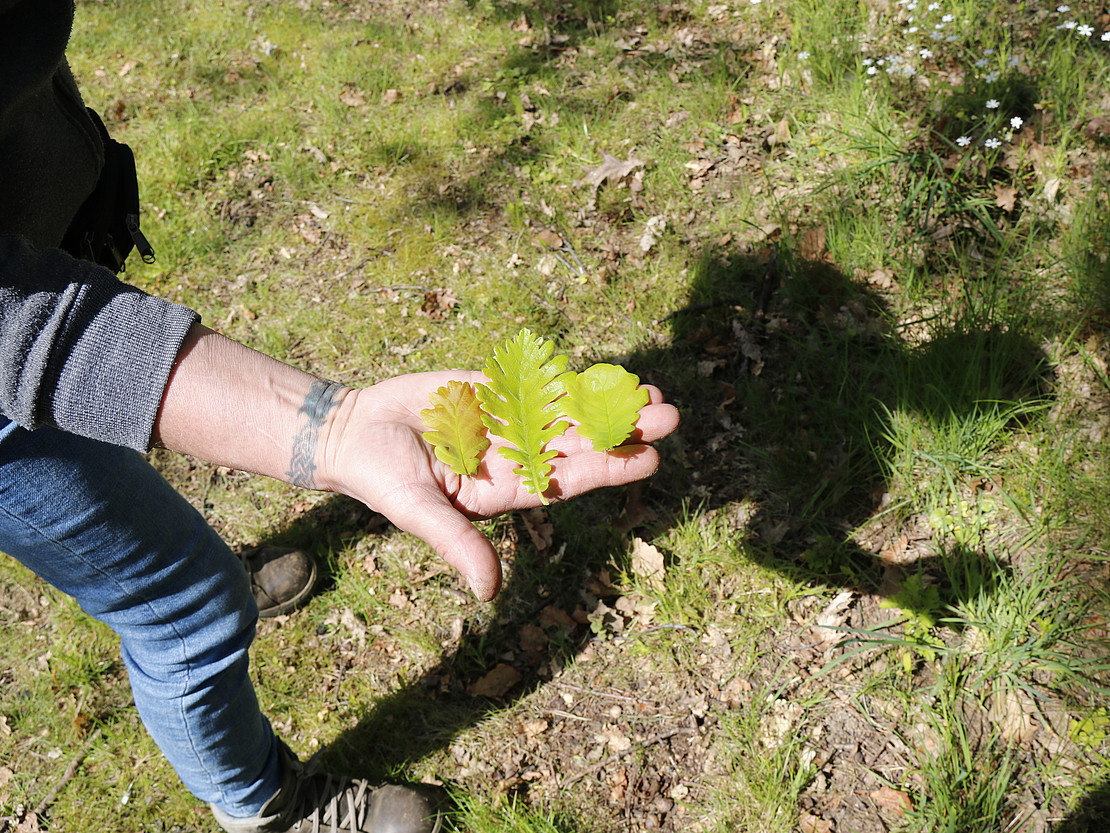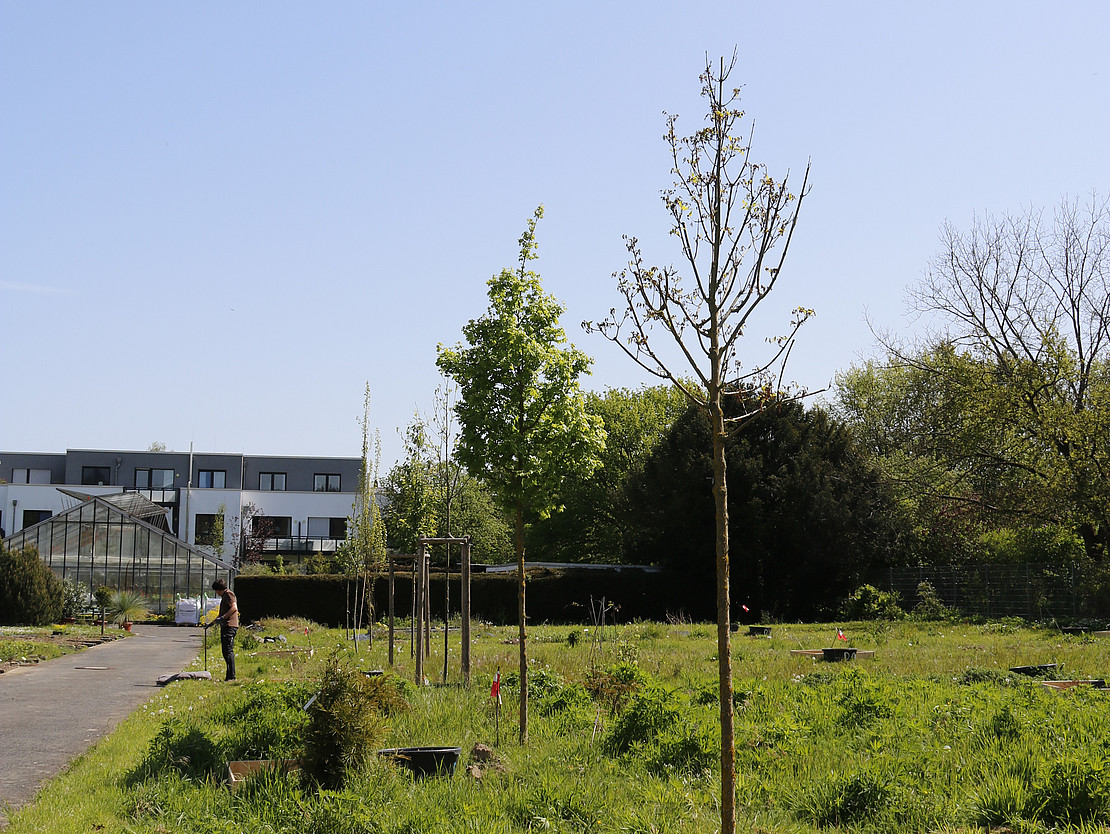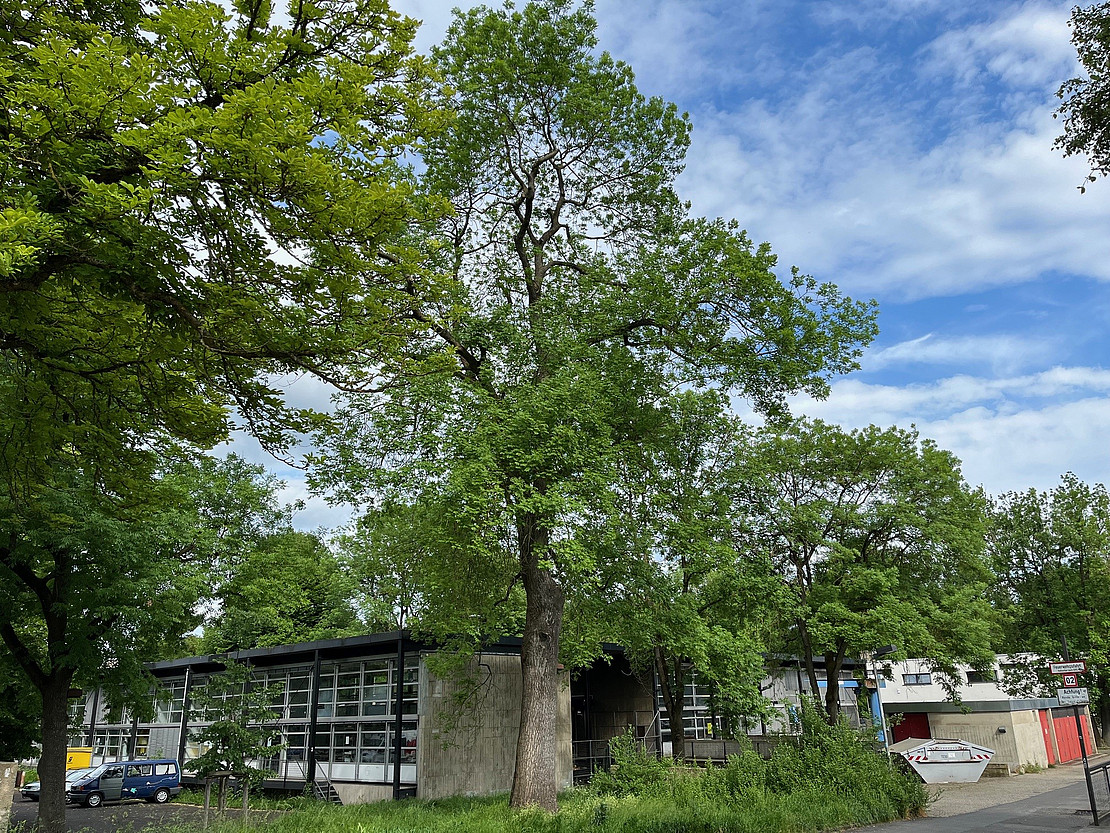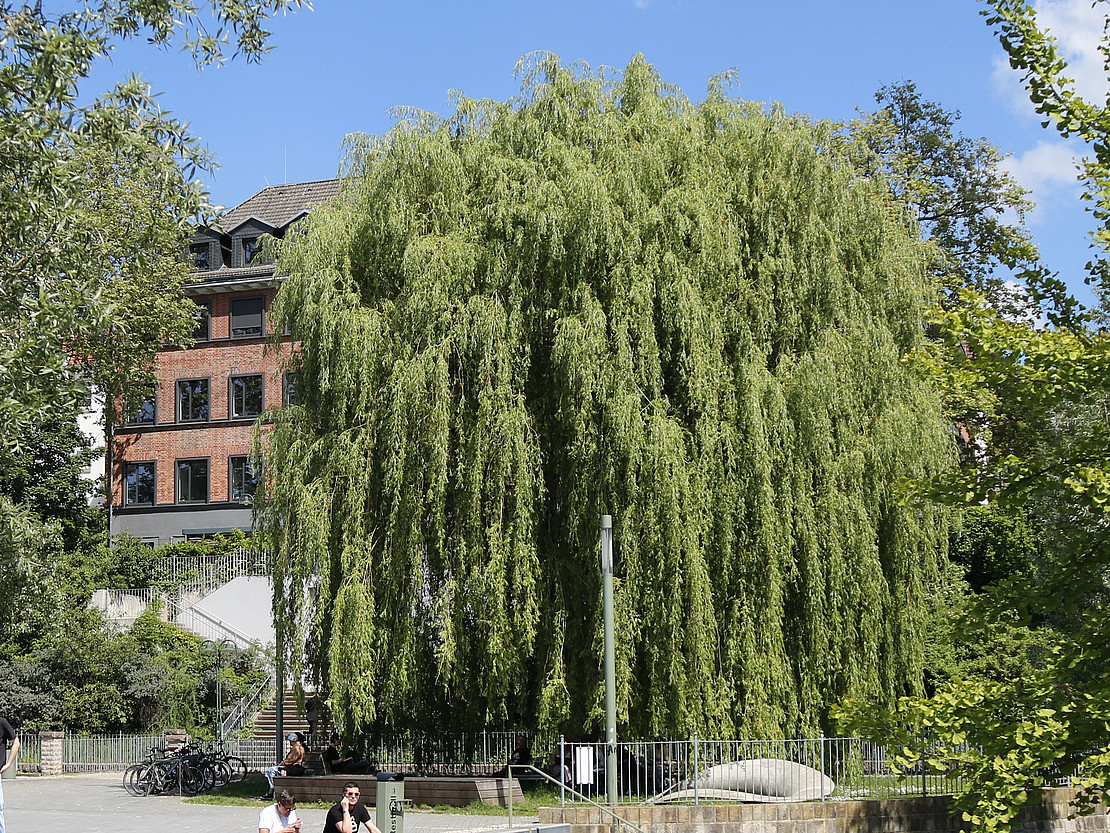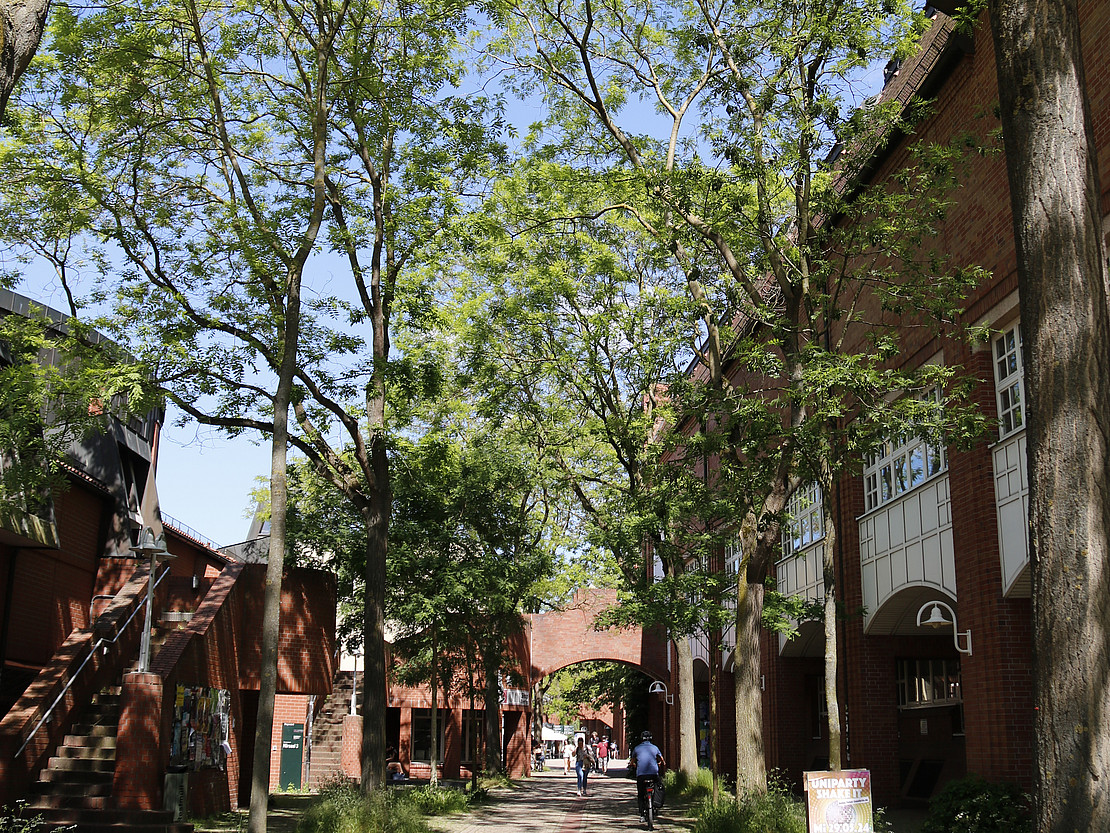This page contains automatically translated content.
Master gardener Bettina Hentrich looks after the university trees on campus
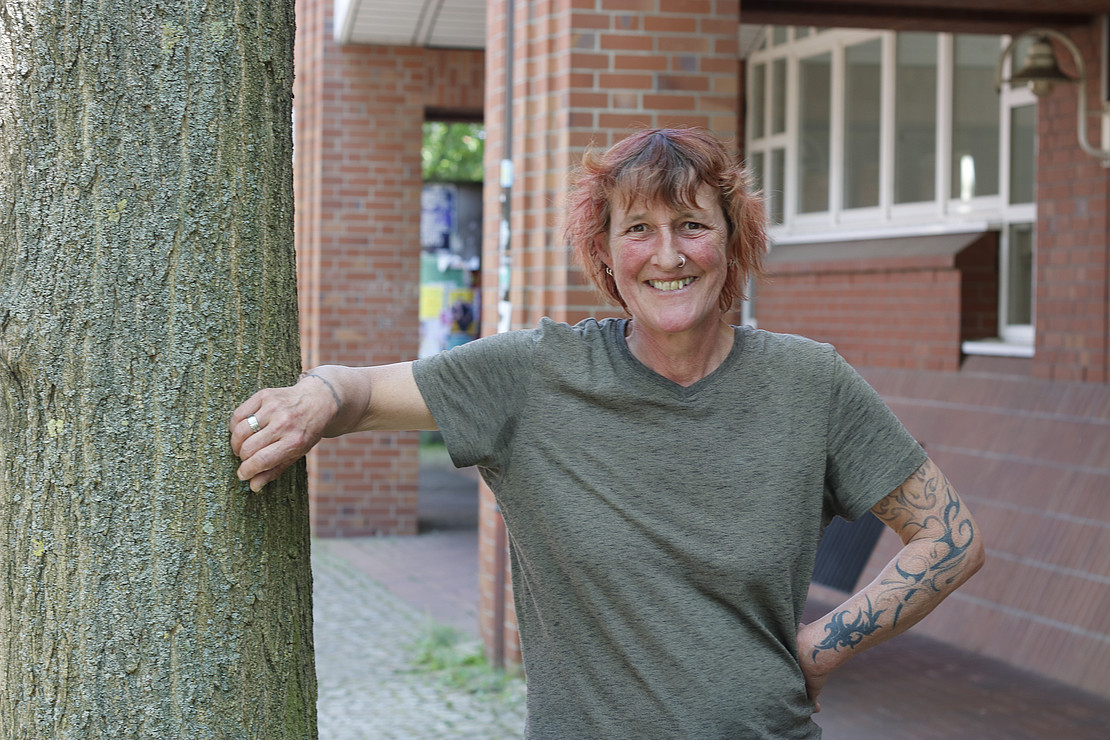 Image: Kathrin Meckbach
Image: Kathrin MeckbachThe sun is shining, the bugs are buzzing, leaves are rustling in the wind - it's a day in spring and I have an appointment with Bettina Hentrich. The master gardener is taking me on a tree tour. Who would have thought it: over 1,500 trees grow on the various sites of the University of Kassel. Today I'm getting to know the most beautiful specimens and their special stories. As we set off, Bettina Hentrich tells me that all the trees are listed in a tree register. "All the important information about each tree is collected here - species, year of planting, location, size and height as well as maintenance measures." The register shows, for example, that there are 60 tree genera with over 134 varieties and species on campus - a huge variety. She herself created the register on index cards in 2005, but today the information can be accessed digitally.
Our first stop is the site on Wilhelmshöher Allee. The first highlights await us here - probably the oldest and the youngest tree at the university. The magnificent copper beech was planted around 1910. "We don't know the exact date, but we can make a good estimate based on the circumference of the trunk and the height," says Hentrich. In the case of the youngest tree, a hornbeam, the case is clear; it was planted last fall. Hentrich is particularly pleased with the color contrast between the delicate green leaves of the hornbeam and the dark red leaves of the copper beech. The tour continues to a copper beech, also around 100 years old, in front of the CESR building (Wilhelmshöher Allee, corner of Sophienstraße). The imposing tree is so valuable that it has been placed under a preservation order by the city. "Trees that characterize the appearance of a place receive such an award. They are therefore specially protected and may only be felled in exceptional cases and with permission," explains the master gardener.
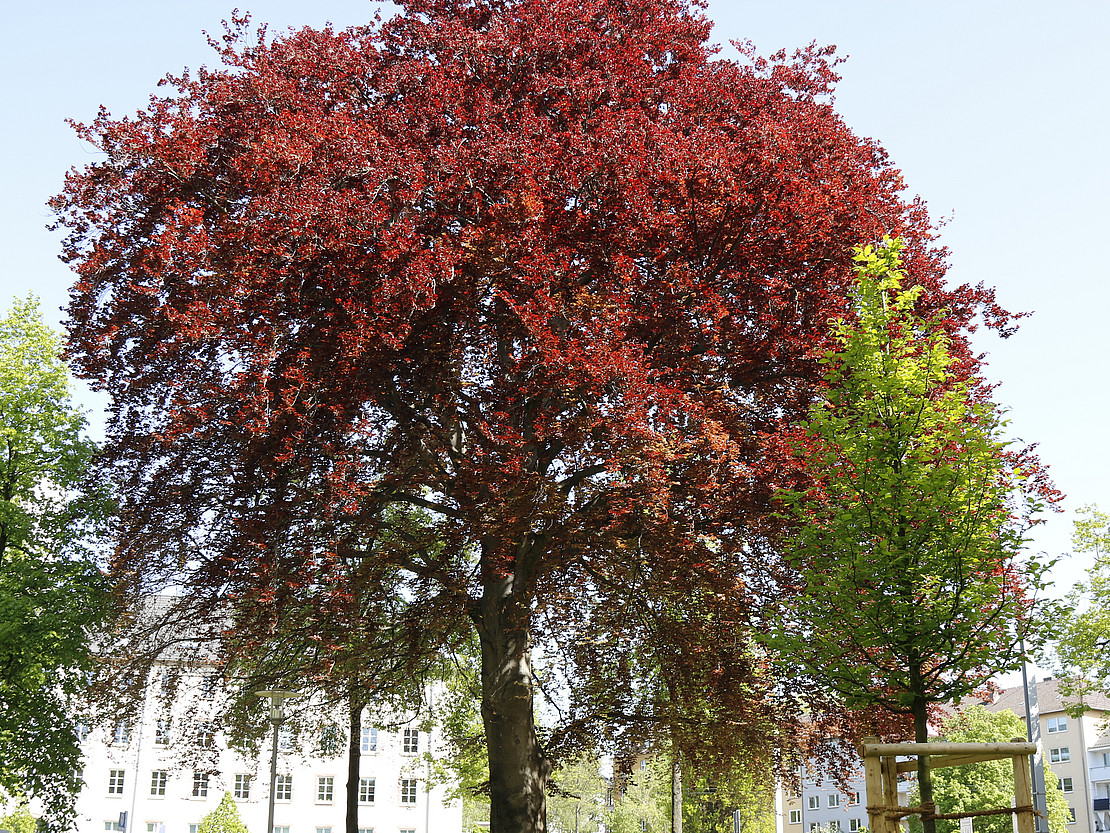 Image: Kathrin Meckbach
Image: Kathrin MeckbachBettina Hentrich has been working at the university since 1998, initially at the Witzenhausen site. A few years later, the opportunity arose to take on a master craftswoman position at Holländischer Platz. Hentrich completed her training to become a master craftswoman while working, with lessons at weekends over a period of two years. Today, she manages the maintenance of the outdoor facilities at the various locations. She has a wide range of tasks, from maintaining the flower beds in spring to cutting the grass in summer, removing leaves in fall and clearing snow in winter. She is supported by three colleagues. More than 1,500 trees on the university campus are a lot of work, but Hentrich's stories are full of joy.
"I check them regularly: are they affected by rot, disease or pests, is there storm or frost damage, could branches fall on people? Young trees are usually unproblematic, but the older the trees get, the more often I check on them, usually in May or June when the canopy is full and again in winter when the leaves have fallen." If a tree still cannot be saved, it is replanted. "The small trees have usually been pre-grown in nurseries for several years," explains Hentrich. "We prefer to plant younger trees, as they can still get used to the new location. After planting, we water the new plantings for another three to six years. This period has also been extended due to the long periods of drought." We drive on to the AVZ in Oberzwehren. An arboretum was created here back in the 1970s. The various tree species are used for educational purposes, both for the university and for the nearby schools. Various types of oak grow here, for example, as well as firs, spruces and even a giant sequoia.
On the other side of the road, next to the greenhouse, the gardeners have planted an "avenue of the future" - with tree species that, according to current knowledge, can adapt well to extreme climatic conditions. "Here we are testing how hornbeam, ash, field maple, poplar and various types of rowan can cope with a lack of water and long periods of heat." Hentrich's explanations reflect his great expertise and many years of experience.
The "television star", an ash tree, awaits us at the art academy. "One day, Hessischer Rundfunk asked us to film a report on rope climbing technology," says Bettina Hentrich. "This is often used for tree care and is a very gentle method, in contrast to the use of aerial work platforms. As the ash tree is over 100 years old and correspondingly large, we demonstrated the technique on it." Over the decades, the ash tree has had to cope with some storm damage. But thanks to special care, it is holding up bravely. "Its soil was loosened with compressed air. This allows the roots to breathe more easily and it can absorb water better. It has also been given a substrate with nutrients."
Good tree care is more important than ever due to climate change. They absorb carbon dioxide and pollutants from the air and store them in their trunk, branches and leaves. A single tree is able to produce oxygen for two people, thus ensuring physical and mental health. They reduce noise, provide shade, store water and release it back into the environment through evaporation - a cooling effect. They provide a habitat for insects, birds and small animals. Trees are irreplaceable for the urban climate in particular - at the same time, they find the most difficult conditions here. More trees are to be planted at the university over the next few years. In particular, green spaces are being considered in the planning of the new buildings for the natural sciences on the North Campus (as are green roofs and facades). The young trees on the newly renovated Moritzstrasse are a first step in this direction.
We have now arrived at the Holländischer Platz campus - the end of our tree tour. Here, too, some special trees await us. Everyone knows the weeping willow in front of the cafeteria - who hasn't tried to get one of the coveted summer spots under the hanging branches for their lunch break? It is also over 100 years old and has provided shade for the Henschel workers. One of Bettina Hentrich's favorite trees is in the inner courtyard of the guest house in Mönchebergstraße: a Paulownia, which she affectionately calls "Paulinchen". The colorful purple flowers usually adorn it in May. Unfortunately, the tree did not cope well with the late frost this year and only produced a few flowers. However, new shoots give Hentrich hope that "Paulinchen" will survive the damage well.
Some of Joseph Beuys' famous oak trees have also found their place at the university. From 1982, the artist planted 7,000 oaks in Kassel for documenta 7 as part of the project "Stadtverwaldung statt Stadtverwaltung" (urban forestation instead of city administration), easily recognizable by the corresponding basalt steles. At Hopla, in front of the central administration, at Café Desasta and at K10, there are several tree artworks, as well as at the art academy and in front of the engineering school in Wilhelmshöher Allee.
The sophores in the diagonal at Holländischer Platz form a small avenue. Hentrich also has a little story to tell about these trees: "To me, they always look as if they want to leave their place and run away because they stretch their roots upwards and tear up the pavement." There are also a few fruit trees on the Hopla campus. Their locations will not be revealed here. If you look carefully, you will be rewarded with delicious pears and apples in late summer and fall.
This article appeared in the university magazine publik 2024/2. Text: Kathrin Meckbach
